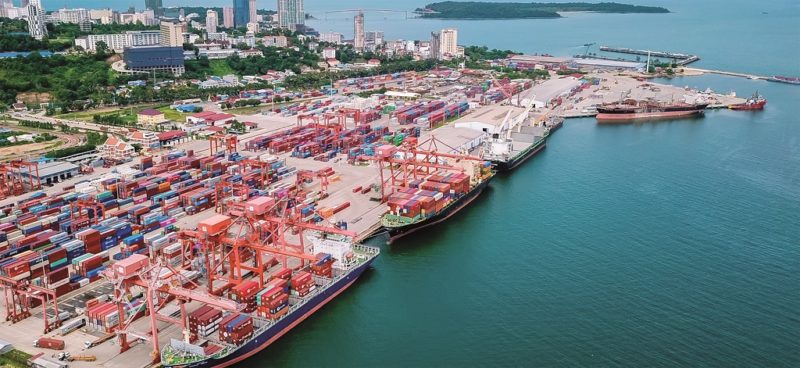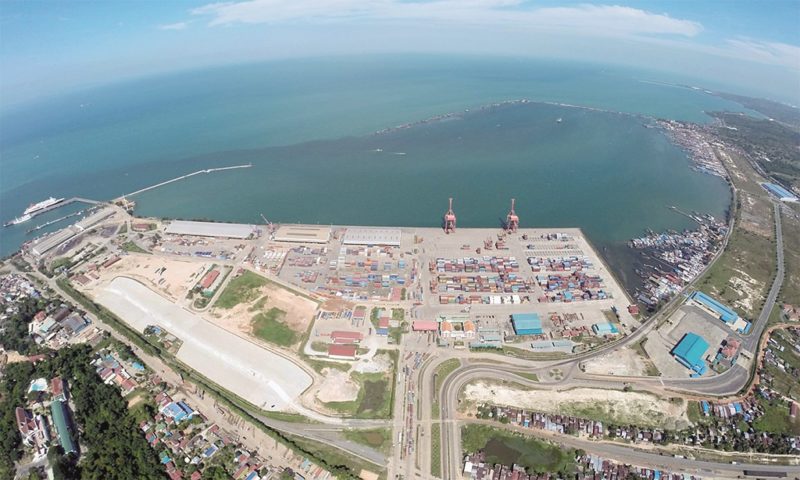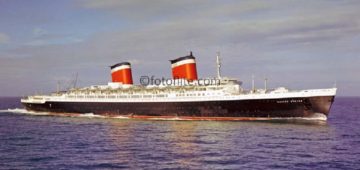
Many readers will be forgiven if they thought that Cambodia was a landlocked country in South East Asia, and originally part of the French Far East possession of Indo – China of Cambodia, Laos and Vietnam until 1955. The Kingdom of Cambodia has this reasonably sized coastal port in Si-Province at the tip of an elevated peninsula in the south west part of the country with access from the Gulf of Thailand. There is also a river port at the capital of Phnom Penh handling barges on the majestic Mekong river. Phnom Penh is the ancient and long serving capital of the country, and Sihanoukville is the second biggest city of around 90,000 people covering an area of 75.64 square miles.
Sihanoukville is named in honour of the former King of Cambodia, Norodom Sihanouk, who abdicated in 1960, having proclaimed Cambodia independent of the French in 1944 when the Japanese had occupied the country. The monarchy having survived for many centuries, much longer than the French occupation as a colony since 1863. The city was founded only relatively recently on 22nd November 1957, and is a very vital and only deep water port city for Cambodia on the busy trade route bringing supplies in from China, as well as exporting Cambodian goods. Cambodia was known as the Khmer Republic, with the Khmer Empire having flourished for six centuries from around 800 to 1450 AD, and with the Khmer capital of Angkor Wat in the north west of the country. In January 1976, the Khmer Republic became Democratic Cambodia, and the Khmer culture and language is still the principal culture and language in Cambodia today.
Sihanoukville is also the largest seaside resort in Cambodia with eight gorgeous beaches, as well as the nearby Asean Heritage Park, and the very beautiful Kirirom National Park, Preah Monivong National Park, Botum Sakor National Park, Phnom Kulen National Park, Ream National Pak, Kep National Park and Virachey National Park spread across the whole of Cambodia.
HISTORY OF SIHANOUKVILLE
The city and port have an alternative name of Kompong Som adopted from the local indigenous population. After the dissolution of French Indo-China, it became apparent that the increasingly tightening control of the Mekong Delta by Vietnam required a solution to gain unrestricted access to the sea. Plans were made to construct an entirely new deep water port at Kompong Som with a good depth of water and ease access from the sea. In August 1955, a French and Cambodian joint construction team began hacking their way through the forests from a small base camp towards the sea to reach the area around Sihanoukville. Funds for the construction of the port came from France, and the new road was financed by the United States of America. The port had been opened in June 1955 with a new jetty at right angles to the shore of two berths, with vessels berthing on both the interior and exterior of the jetty. The port was subsequently increased in 1966 to eight cargo berths with the construction of a new wharf, and the construction of a container terminal with modern cargo handling equipment and four gantry cranes that was completed in March 2007.

Strangely, the new port became a military facility for both sides of the twenty year Vietnam War. Vietnam guerrillas of the National Front for the Liberation of South Vietnam used it until 1970, and then it came under the Government of Lon Nol in the service of the United States of America. The port was the last place to be evacuated by the U. S. Army, only days before the Khmer Rouge guerrillas took control of the government in April 1975. The events surrounding the seizing of the American container ship Mayaguez and her crew on 12th May 1975 by the Khmer Rouge and the subsequent retaking of the vessel by U. S. Marines in the waters of Koh Tang off Sihanoukville have been largely forgotten. During two days of action, the U. S. A. began air strikes on the mainland of Sihanoukville including the port and Ream Naval Air Base, a railroad yard and the petroleum refinery, in addition to air strikes and naval gunfire on several Cambodian islands in the Gulf of Thailand.
After the fall of the Khmer Rouge regime in 1979 and the subsequent opening up of the economy of Cambodia, the port of Sihanoukville regained its importance in the development and recovery of the country, with the port then developed into a modern port with eight cargo berths and a container terminal, as well as two oil terminals located in the deeper water off Sihanoukville, the Sokimex Oil Terminal and Tela Oil Terminal.

The deep water Port of Sihanoukville and the capital of Phnom Penh are today linked by a modern highway. Cambodia has an area of 181,300 square kilometres and is known as Kampuchea today, and its industries and GDP are provided by agricultural products, rice, rubber, maize, pepper, kapok, livestock, fishing, car assembly, cigarette manufacture, textiles, electronic components, timber, plywood, paper, tyres, cement, oil refining and other products. The port is located at position 10°39′ North, 103°30′ East and has a total land area of 125 hectares. The Bay of Kampong Som is protected by a string of beautiful islands against tidal waves and the full force of gales and typhoons, and is deep enough to not require permanent dredging of the navigational channels. Cargo traffic in 2021 amounted to 5.5 million tonnes of imports and exports plus 500,000 TEU of containers. This had increased from the 2015 figure of 3.8 million tonnes of imports and exports, and 391,000 TEU of containers. The deep water Port of Sihanoukville can accommodate ships of up to 20,000 dwt, with container ships of up to 1,500 TEU capacity. A breakwater has been constructed to protect the berths in both rainy monsoon and dry seasons.
Subscribe today to read the full article!
Simply click below to subscribe and not only read the full article instantly, but gain unparalleled access to the specialist magazine for shipping enthusiasts.






Comments
Sorry, comments are closed for this item